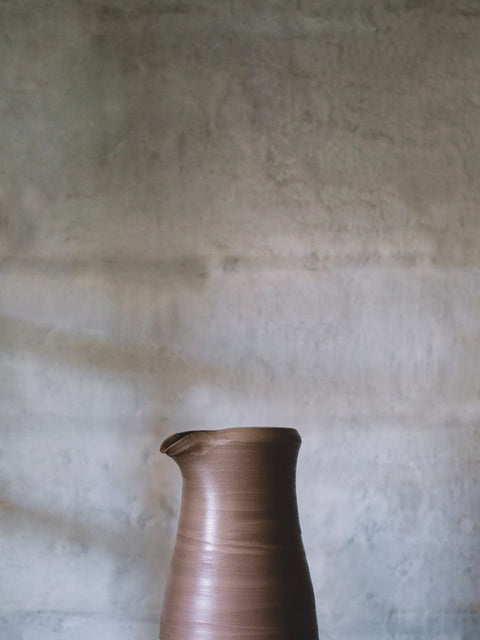BERNARD LEACH ONCE SAID THAT IT WAS HIS SENSE OF HAVING BEEN BORN IN AN ‘OLD CULTURE’ THAT DEFINED HIS ARTISTIC VISION. ‘THE SAP STILL FLOWS FROM A TAP ROOT DEEP IN THE SOIL OF THE PAST’.

A Bernard Leach pot is as much a political statement as an object to admire: its reassuring heft, muted colours, tactile surface, its repetitive scored lines, the areas deliberately left unglazed to show the qualities and provenance of the fired clay, and, above all, the quiet insistence that it must be put to use.

Leach spent the first three years of his life in Japan and his connection to the country never left him. As a teenager, he studied at the Slade School of Fine Art in London under the notoriously judgmental eye of tutor Henry Tonks, who advised him not to become an artist. Leach was nothing if not confident and, in 1909, he returned to Japan with the intention of working as an artist and teaching the art of etching. But it was his chance invitation to a party that crystallised his artistic vision. The guests were there to drink tea and learn the art of raku; the painting, and then low-temperature firing of earthenware pots. Along with the other guests, Leach picked up the strange, unfamiliar brushes and, a little clumsily, decorated two pots that were then fired in a small, portable kiln. He watched as the heat transformed them, peering in through the kiln’s spy-hole as the glaze became ‘melted and glossy’. The covers were removed, and the glowing pieces taken out one by one and placed on tiles. As the shimmer from the heat slowly faded, the true colours came out. ‘Another five minutes passed,’Leach recalled, ‘and we could gingerly handle our pots painted only one hour before.’ In the space of that hour, his artistic ambition changed just as alchemically as the glaze on his pots. Bernard Leach’s subsequent meeting with the celebrated Japanese potter Shōji Hamada was at least as serendipitous as the raku party. The two men became great friends and, in 1920, Hamada returned to St Ives with Leach to help him create his pottery there.

In the early days, Leach’s work followed two paths; there were the coveted, collectable and extremely expensive flasks and bottles that drew on the traditions and aesthetic of Sung Dynasty pots, and alongside them, more affordable domestic stoneware that could be made in greater volume. Ultimately, it was the fusion of these two paths that produced the combustible mix, resulting in what Leach called his ‘standard-ware’, which is still the defining force of Leach pottery today. As the ceramicist Edmund de Waal so shrewdly observed in his intelligent but sometimes critical book about Leach, the phrase ‘standard-ware’ was a powerful one, ‘resonant not only of work being commonly available and having continuity, of being ordinary, but also of his standards: propriety, integrity, authority.’

Leach was also an indefatigable polemicist and pamphleteer, often devoting more time to defining his potter’s manifesto than making pottery itself. In the 1928 pamphlet A Potter’s Outlook, he defined his ideas about affordability, usability and the importance of function as well as form. In particular, he decried the kind of factory-made crockery that was available to all simply because it was ‘cheap, standardised, thin, white, hard and waterproof.’ The shapes were ‘wretched’ he said, ‘the colours sharp and harsh, the decoration banal, the quality absent.’ Above all, he said, the pots were ‘still-born: they have not had the breath of reality in them: it has been a game.’

The roll-call of potters and artists who studied with Leach or worked at the Leach Pottery in St Ives is as long as it is distinguished: Bernard Leach’s sons David and Michael; his potter grandsons Simon, Philip, Jeremy and John; Richard Batterham, Nora Braden, Katherine Pleydell-Bouverie, William Marshall, abstract artist Patrick Heron, Janet Darnell (who became his third wife) and Michael Cardew. Many of them, in different ways, absorbed aspects of Leach’s vision: the flat, cut sides of Batterham’s harmonious bowls, the reassuring curves, muted tones and durable honesty of John Leach’s Muchelney pottery, the fluted lines of David Leach’s bowls. Bernard Leach once said that it was his sense of having been born in an ‘old culture’ that defined his artistic vision. ‘The sap still flows from a tap root deep in the soil of the past’, he said, ‘giving the sense of form, pattern and colour below the level of intellectualisation.’ Some would argue with that definition; it seems to exclude the idea of future innovation, as well as to suggest that without a sense of history there can be no artistic integrity. Perhaps the vision of the tap root could be deployed more usefully as a representation of Bernard Leach’s own influence. From his epiphany at a Japanese raku party at the beginning of the 20th century sprang a new form of studio pottery, producing work that was, and still is, restrained, useful, harmonious and democratically available. The tap root still flourishes today.

- WORDS: Charlie Lee-Potter
- PHOTO: Finn Beales
- ORIGINAL POST: Readcereal

